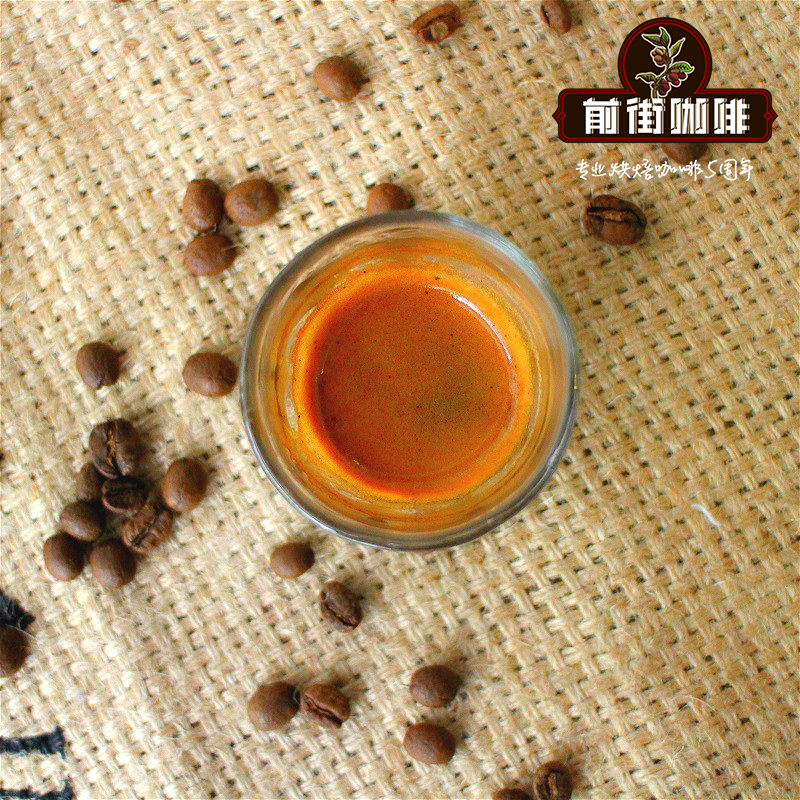The art of blending Italian concentrate | what coffee beans are used for Italian concentration | Italian coffee beans are recommended

Professional coffee knowledge exchange more coffee bean information please follow the coffee workshop (Wechat official account cafe_style)
What is Italian condensed blending? Why isn't the theme coffee blending? Because the blending of French-pressed or drip-filtered coffee does not need to be too accurate, it can not be compared with the complexity and rigor of Italian concentrated blending. The blending of espresso is an art.
After talking for a long time, are you professional or not?
I have been working in a coffee shop for four years, blending more than 200 coffees, using coffee from more than 60 houses, and tasting thousands of espresso cups. My Has Bean Espresso matching is the best seller and has been well received by the industry, especially customers.
Then what makes a good Italian condensed mix?
First of all, I would like to make it clear that everyone has his own opinion on coffee, and my principles may be different from yours, for reference only.
Good Italian condensation depends on a good mix. On this point, I believe all practitioners agree with me, but the premise is that you have to taste a large number of single espresso, because only after tasting the taste of individual coffee and testing the cup, you will know what flavor each kind of coffee will taste when tasted separately, so that later in the blending process, if you want to add a little sweetness, you will know which country of coffee should be used.
At the same time, record as many details as possible during the cup test, don't be afraid to taste the same coffee over and over again, and dare to try new varieties. No one can make good coffee at once. Everyone must have experienced failure. In addition, the cup test method should be as professional as possible, so that you can really understand each type of coffee. Of course, you can taste it directly with an espresso machine, but this method is lazy and inaccurate. Only a cup test can really make your tongue work, and at the same time let you learn to compare and analyze. Only through comparison and analysis can you really understand the characteristics and differences of each coffee.
The next step is to try, try again! Matching can not be done at once, no one will give you a limited number of times, until you find out the most ideal taste! Cup testing, tasting, adaptation, blending, and then blending, this is the charm of Italian concentrated blending, your work is endless, each batch of coffee has its unique charm, each batch of coffee is unique!
So what is a failed Italian condensed mix?
The failed Italian concoction is catastrophic, and if the baker makes a mistake, he may lose valuable customers. In contrast, the fault tolerance rate of drip matching is very high, even if something goes wrong, people may choose to forgive, because the difference in the proportion of gouache between dripping and Italian concentrate is too big!
A failed Italian condensed match may be too complex, too low in complexity, too silky, too bitter, too fresh or spoiled. You know. My personal favorite Italian condensed mix may be too rich, mellow and expensive for the average consumer. The baker's job is to find the Italian concentrated combination that can meet everyone's needs and find the most suitable balance.
One of the principles I follow is that coffee with high acidity, such as Kenya, should not be made too sour. I remember when I was a teenager at that time, I was eager to express my love for Kenyan coffee, and I wanted to reflect it in spaghetti blending anyway. But in the end, I found that people had no feeling about my Kenyan + Costa Rican mix and suggested that I make drip coffee. Fortunately, this coffee is one of the best drip combinations I sell now, so don't be afraid to fail, any attempt is worth it!
About baking
Baking is a very important step in Italian concentration and blending. There are roughly two methods of matching, one is to match first and then bake, and the other is to bake separately and then match. For commercial bakers, it is much easier to bake first and can reduce waste, such as baking too much in a batch of Colombian coffee, and the rest can be used for blending.
But I personally prefer to match first and then bake. As for why I chose this, I can only tell you that it is the result of experience. Blending first can make the coffee taste more uniform and uniform.
With regard to the degree of roasting, I very much agree with the definition of baking degree in David Schomer's book "Espresso Coffee Professional Techniques". I use what I call "northern Italian roasting", which I call medium-to-deep roasting. The coffee is dark reddish brown when it is about to be oiled but not yet oiled. If it were a little deeper, the coffee would taste more bitter (but in Starbucks' view, this is a good Italian concentrate). If you insist on deep baking, please do it gently so as not to burn the coffee.
Professional skills of Italian concentration and blending
Let's go straight to the point and let me share some exclusive secrets with you today!
one
Yega Xuefei, Ethiopia
For Yega Xuefei, I have already stopped hoarding, mainly because the production of this coffee is limited and sometimes the quality is not guaranteed (for example, the batch in 2002). I started to turn to Cedamo and Gemma, but to be honest, there was nothing like the good Yegashifi. Now I still buy some high-quality Yega Chuefei regularly, which can bring more silky taste and more balanced taste to my blended coffee.
two
Ethiopian long bean Harald
I have to admit that I have been biased against this coffee. Why? Because a few years ago, when I first started the Has Bean website, I tasted a cup of long bean Harar, which turned out to be the sour I've ever had, and it's not a high-quality acid, even worse than some Robusta. So I deliberately avoided this kind of coffee for a long time. But until two months ago, I tasted a new batch of beans, which gave me a new view of it. I decided to add a little bit to the mix, but not in large quantities. I want it to bring some new flavors to my mix, but it can't subvert the taste of other coffees. This coffee has a very similar flavor to Yemeni coffee.
three
Brazil bourbon Fazenda Cachoeira
Until a year ago, the only Brazilian coffee I had in stock was the most common Santos. In my opinion, Brazilian coffee is insipid and lacks personality, so why bother to find small quantities of coffee from small plantations? But occasionally I tasted this coffee, its sweet, silky taste, and my mix is very good.
four
Columbia La Manuela
The taste is silky and smooth, although it is not as sweet as F. Cachoeira, but it can add to the taste of my match.
five
Brazil Santa Terezinha
Its silky and delicate taste balances the sweetness of the entire blend of coffee, while increasing the fineness of the taste to avoid too much sour lemon, making it a perfect blend.
six
Bolivian organic
Full-bodied chocolate aroma can bring the quality of matching to a new level.
seven
Finally, Robusta!
I don't care what people say, all I know is that there's nothing like a spaghetti blend with Robusta! Use less (less than 10%), of course, and use the best Robusta (believe me, I've tasted robusta that tastes better than some Arabica).
Robusta brings more caffeine, better fat and taste balance. Don't let prejudice influence your decision. If the content is less than 10%, you can't drink it at all, and the overall quality of coffee will be greatly improved.
Conclusion
This is just a brief introduction to Italian concoction and baking, about which I can write a whole book, but in order not to let readers fall asleep, I decided to make a brief explanation. I think the key to matching lies in your concept and choice of taste, but don't forget that customers are God, and it is our duty to meet their needs!
I think matching is a strong guarantee for high-quality Italian concentration. I can adapt to poor machines, without powder hammers, I can use bottled water without filters, and I'm even willing to use old-fashioned mocha pots, but if they don't match well, I'm sorry, goodbye!
Qianjie coffee: Guangzhou bakery, the store is small but a variety of beans, you can find a variety of unknown beans, but also provide online store services. Https://shop104210103.taobao.com
Important Notice :
前街咖啡 FrontStreet Coffee has moved to new addredd:
FrontStreet Coffee Address: 315,Donghua East Road,GuangZhou
Tel:020 38364473
- Prev

Does SOE coffee taste better? The difference between Italian spelling and SOE
Professional coffee knowledge exchange More coffee bean information Please pay attention to coffee workshop (Weixin Official Accounts cafe_style) Go to coffee shop and order a cup of coffee. Have you ever been asked by barista: Would you like to try our SOE? SOE stands for Single Origin Espresso, which is a single origin espresso. Many people think that a single origin competition with coffee (
- Next

How to bake kadura coffee beans _ Kaddura coffee brewing suggestion _ how much is a cup of Kaddura coffee
Professional coffee knowledge exchange more coffee bean information please follow the coffee workshop (Wechat official account cafe_style) Kaddura coffee bean varieties introduced in Colombia early growing varieties are the old tin pickup and bourbon, began to be replaced by Kaddura in 1970; Kaddura is not only higher yield per plant than tin truck and bourbon, but also because the tree shape is more compact, so the unit planting area
Related
- Beginners will see the "Coffee pull flower" guide!
- What is the difference between ice blog purified milk and ordinary milk coffee?
- Why is the Philippines the largest producer of crops in Liberia?
- For coffee extraction, should the fine powder be retained?
- How does extracted espresso fill pressed powder? How much strength does it take to press the powder?
- How to make jasmine cold extract coffee? Is the jasmine + latte good?
- Will this little toy really make the coffee taste better? How does Lily Drip affect coffee extraction?
- Will the action of slapping the filter cup also affect coffee extraction?
- What's the difference between powder-to-water ratio and powder-to-liquid ratio?
- What is the Ethiopian local species? What does it have to do with Heirloom native species?

